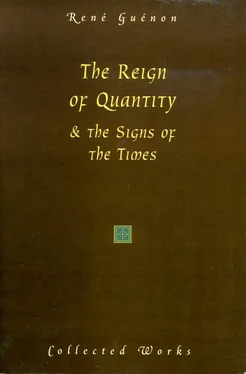The distinction between these two fundamental categories of symbols is, in the Hindu tradition, that between the yantra , a figured symbol, and the mantra , a sonorous symbol; it naturally carries with it a corresponding distinction in the rites in which these symbolical elements are respectively used, though there is not always such a clear separation as can be conceived theoretically; in fact, every combination of the two in different proportions is possible.
It is scarcely necessary to observe that, in all the considerations now under examination, the correlative and in a way symmetrical character of the spatial and the temporal conditions, seen under their qualitative aspect, becomes clearly apparent.
This is why nomadism, in its ‘malefic’ and deviated aspect, easily comes to exercise a ‘dissolving’ action on everything with which it comes into contact; sedentarism on its side, and under the same aspect, must inevitably lead only toward the grossest forms of an aimless materialism.
As Abel shed the blood of animals, his blood was shed by Cain; this is as it were an expression of a ‘law of compensation’ by virtue of which the partial disequilibria, in which the whole of manifestation consists fundamentally, are integrated in the total equilibrium.
It is important to note that the Hebrew Bible nevertheless admits the validity of the bloodless sacrifice considered in itself: as in the case of the sacrifice of Melchizedek, consisting in the essentially vegetable offering of bread and wine; but this is really connected with the rite of the Vedic Soma and the direct perpetuation of the Hebraic and ‘Abrahamic’ tradition and even much further back, to a period before the laws of the sedentary and nomadic peoples were distinguished; this again recalls the association of a vegetable symbolism with the ‘Terrestrial Paradise’, that is, with the ‘primordial state’ of our humanity. The acceptance of the sacrifice of Abel and the rejection of that of Cain are sometimes pictured in rather a curious symbolical way: the smoke of the former rises vertically toward the sky, whereas the smoke of the latter spreads horizontally over the surface of the earth; thus they trace respectively the altitude and the base of a triangle representing the domain of human manifestation.
These two tendencies are again manifested in movement itself, in the form of centripetal and centrifugal movement respectively.
Equilibrium, harmony, and justice are really but three forms or aspects of one and the same thing; they could even in a certain sense be brought respectively into correspondence with the three domains shortly to be referred to, on condition of course that justice be taken in its most immediate meaning, of which in the modern world mere ‘honesty’ in commercial transactions represents an expression, diminished and degraded by the reduction of all things to the profane point of view and the narrow banality of ‘ordinary life’.
The intervention of the spiritual authority in the matter of money in traditional civilizations is directly connected with what has just been said: indeed money itself is in a certain sense the very embodiment of exchange, hence a much more exact idea can be formed of the real purpose of the symbols that it bore and that therefore circulated with it, for they gave to exchange a significance quite other than is contained in its mere ‘materiality’, though this last is all that it retains under the profane conditions that govern the relations of peoples, no less than those of individuals, in the modern world.
It is true that among many peoples the buildings of most ancient date were of wood, but such buildings were obviously not so durable, and consequently not so fixed, as stone buildings; the use of minerals in building thus always implies a greater degree of ‘solidity’ in every sense of the word.
Deut. 27:5-6.
Hence the continuing employment of stone knives for the rite of circumcision as well.
1 Kings 6:7. Nevertheless the Temple of Jerusalem held a large quantity of metallic objects, but their employment is connected with the other aspect of the symbolism of metals, which is twofold, as we shall see presently: it seems moreover that the prohibition ended by being to some extent ‘localized’, mainly against the use of iron, and iron is the very metal of all others that plays the predominant part in modern times.
In the Zoroastrian tradition it seems that the planets were envisaged almost exclusively as ‘malefic’; this may be the result of a point of view peculiar to that tradition, but in any case all that is known about what still remains of Zoroastrianism consists only of fragments so mutilated that it is not possible to form any exact judgment on such questions.
As concerns the relationship to the ‘subterranean fire’, the obvious resemblance of the name of Vulcan to that of the Biblical name Tubalcain is particularly significant: moreover they are both said to have been smiths; and while on the subject of smiths it may be added that the association of their craft with the ‘infernal regions’ sufficiently explains what was said above about its ‘sinister’ aspect. The Kabires, on the other hand, while they too were smiths, had a dual aspect both celestial and terrestrial, bringing them into relationship both with the metals and the corresponding planets.
It should be stated that alchemy properly so called did not go beyond the ‘intermediary world’ and held to a point of view that may be called ‘cosmological’, but its symbolism was nonetheless capable of being transposed so as to give it a truly spiritual and initiatic value.
The case of money, as it stands today, can also serve as a typical example: deprived of everything that was able, in traditional civilizations, to make it as it were a vehicle of ‘spiritual influences’, not only is it now reduced to being in itself no more than a mere ‘material’ and quantitative emblem, but also it can no longer play a part that is otherwise than truly nefarious and ‘satanic’, and it is all too easy to see that such indeed is the part it plays in our time.
This prohibition is in force, at least in principle, notably in the Islamic rites of pilgrimage, though in fact it is no longer strictly observed today; furthermore, anyone who has accomplished these rites in their entirety, including that part of them that constitutes their most ‘interior’ aspect, must thenceforth abstain from all work involving the use of fire, and this includes more particularly the work of blacksmiths and metallurgists.
In Western initiations this takes the form, in the ritual preparation of the recipient, of what is designated as the ‘stripping of metals’. It could be said that in a case of this kind the metals, apart from their real power to affect adversely the transmission of ‘spiritual influences’, are taken as representing more or less what the Hebrew Kabbalah calls the ‘rinds’ or the ‘shells’ ( qlippoth ), meaning all that is most inferior in the subtle domain, thus constituting, if the expression be allowable, the infra-corporeal ‘pit’ of our world.
Thus, those who in the first half of the nineteenth century wrote ‘histories of religion’ invented something to which they applied the word ‘symbolical’, which was a system of interpretation having only a very remote connection with true symbolism; as for merely literary misuses of the word ‘symbolism’, they are evidently not worth the trouble of mentioning.
Читать дальше











